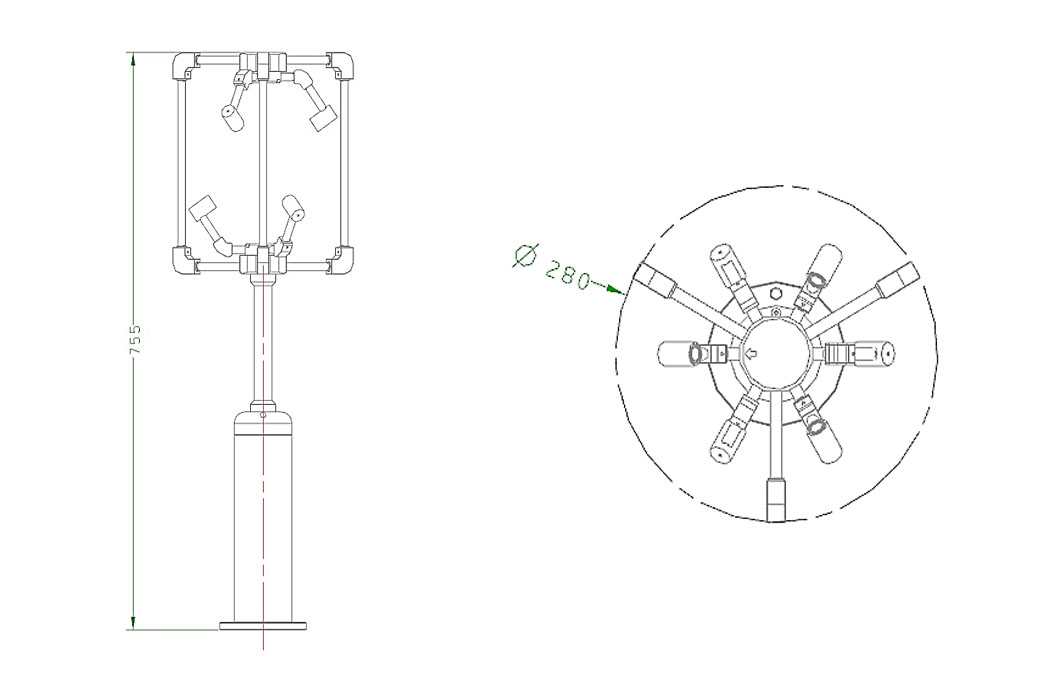

— Blogs —
—Products—
 Consumer hotline +8618073152920
Consumer hotline +8618073152920 WhatsApp:+8615367865107
Address:Room 102, District D, Houhu Industrial Park, Yuelu District, Changsha City, Hunan Province, China
Product knowledge
Time:2024-07-28 15:30:53 Popularity:355
2D anemometers and 3D anemometers are instruments used to measure wind speed and direction, the main difference between them is the dimension of the measurement.
2D Anemometer
Definition:
2D anemometer, also often called 2D ultrasonic wind speed and direction meter, 2D ultrasonic wind speed and direction meter, is mainly used to measure the horizontal component of wind speed and direction. It uses the principle that the propagation speed of ultrasonic waves in the air changes with the wind speed, and calculates the wind speed and direction by measuring the arrival time or frequency change of the ultrasonic waves.
Characteristics:
The main focus is on the horizontal component of wind speed and direction.
Measurements are usually transmitted via analogue or digital signals.
Highly accurate and suitable for measurements under a wide range of environmental conditions.
3D Anemometer
Definition:
A 3D anemometer, or three-dimensional ultrasonic anemometer, is an instrument capable of accurately measuring wind speed and direction in three dimensions. It is also based on the ultrasonic measurement principle, but measures simultaneously in three mutually perpendicular directions, thus obtaining the wind components (u, v, w) in the three directions and the instantaneous total wind speed.
Features:
Capable of measuring the three-dimensional components of wind speed and direction.
High resolution and long-term stability, suitable for continuous observation and field environment.
High sensitivity, easy to record and store data, it is an important instrument for pulsation determination.
Difference between 2D and 3D anemometer
| 2D anemometer | 3D anemometer | |
| Measurement dimension | Only the horizontal components of wind speed and direction are measured | Measure the three-dimensional components of wind speed and direction (u, v, w) |
| Application scenario | Applicable to scenarios that require high horizontal wind speed and direction | Suitable for complex environments that require a comprehensive understanding of wind speed and direction changes |
| Measurement accuracy | Higher, but only horizontally | Higher to capture more subtle changes in wind speed and direction |
| Technical difficulty | Relatively low | Higher, requiring more sophisticated sensors and data processing techniques |
| cost | Relatively low | Relatively high |
There are significant differences between 2D and 3D anemometers in terms of measurement dimensions, application scenarios, measurement accuracy and technical difficulties, etc. 2D anemometers are suitable for scenarios with high requirements on horizontal wind speed and direction, while 3D anemometers can provide more comprehensive information on wind speed and direction, and are suitable for complex environments and scientific research.
Application Scenarios for 2D and 3D Anemometers
Applications for 2D anemometers
Meteorological field: Used in weather stations and weather satellites to provide accurate information on horizontal wind speed and direction.
Transportation: To assist in landing aircraft and vehicles, providing important data on wind speed and direction.
Agriculture: Helps farmers to understand local meteorological conditions and plan their planting.
Construction industry: to assess the wind environment around buildings.
Marine activities: such as sailing, monitoring wind direction and speed.

Application Scenarios of 3D Anemometer
Meteorological field: real-time monitoring of three-dimensional changes in wind speed and direction, providing comprehensive data support for meteorological forecasting and research.
Environmental protection field: monitoring the diffusion of pollutants in the atmosphere, providing decision-making basis for environmental protection departments.
Architecture: Used in building wind tunnel tests to evaluate the wind pressure and vibration performance of buildings.
Scientific research: Used to accurately measure the vertical component of wind speed in scientific research such as vorticity correlation method.
Wind power generation: to evaluate wind resources and optimise the placement of wind turbines.
Summary
Both 2D and 3D anemometers are important wind speed measurement tools, and they have their own advantages and applications in monitoring wind speed and direction. 2D anemometers are suitable for situations where the need for vertical wind speed measurement is not high, while 3D anemometers are suitable for complex environments where comprehensive information about the wind field is required. Users should decide which type of anemometer to use based on their specific needs and budget.
Related recommendations
Sensors & Weather Stations Catalog
Agriculture Sensors and Weather Stations Catalog-NiuBoL.pdf
Weather Stations Catalog-NiuBoL.pdf
Related products
 Combined air temperature and relative humidity sensor
Combined air temperature and relative humidity sensor Soil Moisture Temperature sensor for irrigation
Soil Moisture Temperature sensor for irrigation Soil pH sensor RS485 soil Testing instrument soil ph meter for agriculture
Soil pH sensor RS485 soil Testing instrument soil ph meter for agriculture Wind Speed sensor Output Modbus/RS485/Analog/0-5V/4-20mA
Wind Speed sensor Output Modbus/RS485/Analog/0-5V/4-20mA Tipping bucket rain gauge for weather monitoring auto rainfall sensor RS485/Outdoor/stainless steel
Tipping bucket rain gauge for weather monitoring auto rainfall sensor RS485/Outdoor/stainless steel Pyranometer Solar Radiation Sensor 4-20mA/RS485
Pyranometer Solar Radiation Sensor 4-20mA/RS485
Screenshot, WhatsApp to identify the QR code
WhatsApp number:+8615367865107
(Click on WhatsApp to copy and add friends)